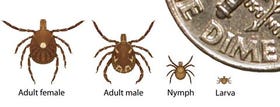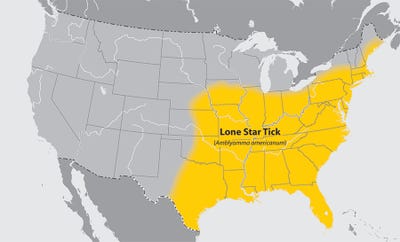April 25, 2016

 A tick-related allergy has been spreading across the southern and eastern part of the United States, according to the Centers for Disease Control and Prevention. Apparently, a bite from lone star ticks in some people can trigger sensitivity to red meat that can result in symptoms such as itching, hives, swollen lips and breathing problems.
A tick-related allergy has been spreading across the southern and eastern part of the United States, according to the Centers for Disease Control and Prevention. Apparently, a bite from lone star ticks in some people can trigger sensitivity to red meat that can result in symptoms such as itching, hives, swollen lips and breathing problems.
Yes, it is actually possible. A tick bites you many moons ago, you keep eating meat, the allergy builds and you find yourself with life-threatening symptoms. However, keep in mind, to date only thousands have been diagnosed and not everyone bitten by the lone star tick develops the allergy.
Just imagine not being able to sink your teeth into a thick, delicious pork chop or never eating a crispy, slice of bacon. That is exactly what an increasing number of individuals are facing after an itchy encounter with a tick identified with a single spot on its back.
Scientists say the lone star ticks pick up galactose-alpha-1, 3-glactose or alpha-gal after the insect bites a deer. When it later bites humans, it passes on the alpha-gel — a substance also found in beef, pork and lamb. The immune system treats the alpha-gel as an enemy invader. So when the human eats meat following a tick bite, the alpha-gel present in meat can activate the immune system to fight, which leads to life-threatening symptoms in some individuals. The allergy was hard to diagnose. For most individuals, a big red rash was easy to detect right away from the tick bite, however the meat-related allergy can take years to develop. The frustrating part is the symptoms do not surface until three to eight hours after consuming meat, making it difficult to draw a connection between the allergy and food.
Scott Commins, M.D., a researcher at the University of North Carolina, was the first to identify the allergy. Thanks to his work, a single blood test can now help doctors diagnose the allergy. Commins once thought this was a regional concern but it is actually being dealt with around the world.
Unfortunately, there is no way to reverse the allergy. For now, impacted individuals must adjust his or her diet by completely avoiding meat. For this meat-loving person, it would be a pure nightmare. I mean just imagine never eating bacon or pork chops again. Being a hard-headed person, I probably would actually give in and eat an occasional red meat favorite, hoping the allergy would just magically cure itself.
The map from the CDC shows the states the lone star tick is located.

The only fool-proof protection is dodging being bit by the lone star tick altogether by avoiding dense woods and brushy areas. So be advised and arm yourself because I know there is no way you as farmers and livestock producers are going to simply stay away from wooded areas or tall grass.
So the experts offer these tips.
If you do enter tick habitats, use the proper repellant with at least 20% DEET on exposed skin and wear protective clothing.
Remember to check your clothes and body after returning to the indoors.
If you find a tick on your body, gently pull it straight up and out with tweezers and disinfect the bite area with rubbing alcohol or soap and water.
Be aware, be safe and farm on.
You May Also Like



